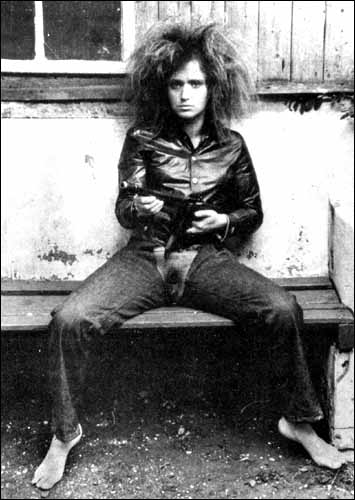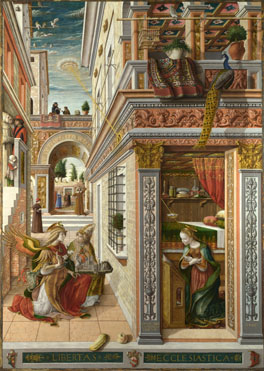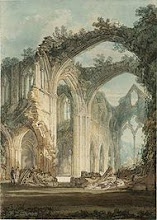To contemporary artists Beauty is to be subverted. Avant-garde artists rejoice in shocking people like the elderly. Is that all they can do? This is financed by Global corporations and appropriating taxpayer’s money for the elites aims. The Avant-garde have a desire to be part of the latest thing but use the same old subjects and are dated.
A walk through Tate Modern and The National gallery opens up contemplation of good and evil, and how evil is being spread to our disadvantage in contemporary civilisation.
 I looked at what early works in the dominant strand in contemporary art in the Tate Modern which act out ideology rather than embody profound intuitions or inspiration. The video “Meat Joy” by Carolee Schneemann from 1964 at the Festival de la Libre Expression in Paris. The title says it all about the delusion of free expression or pure art when content implies form and form should express content more clearly. "Meat Joy" claimed to be “exploring the gap between the conscious and unconscious, the real and the conceptual and an investigation and demystification of the hedonistic concept of the primeval ritual with its "excessive, indulgent... celebration of flesh as material." But it is no more profound explication of these ideas than the average porn film with which it shares form and content. Where the Avant-garde differs from porn is that it is pretentious and makes extravagant claims about itself in sentences of unfathomable abstractions.
I looked at what early works in the dominant strand in contemporary art in the Tate Modern which act out ideology rather than embody profound intuitions or inspiration. The video “Meat Joy” by Carolee Schneemann from 1964 at the Festival de la Libre Expression in Paris. The title says it all about the delusion of free expression or pure art when content implies form and form should express content more clearly. "Meat Joy" claimed to be “exploring the gap between the conscious and unconscious, the real and the conceptual and an investigation and demystification of the hedonistic concept of the primeval ritual with its "excessive, indulgent... celebration of flesh as material." But it is no more profound explication of these ideas than the average porn film with which it shares form and content. Where the Avant-garde differs from porn is that it is pretentious and makes extravagant claims about itself in sentences of unfathomable abstractions. For example, Hermann Nitsch was described as “The Pope of Viennese 'Aktionism'." It is said he shunned the illusionary confines of traditional painting and sculpture, reinventing an art that exists in real, corporeal, and violent terms. In the psueds language of the Saatchi Gallery “ Hermann Nitsch “… took the semblance of a pagan ceremony and incorporated robed processions, symbolic crucifixion, drunken excess, nudity, animal sacrifice, the drinking of blood, and the ritualistic incorporation of viscera and entrails.”
For example, Hermann Nitsch was described as “The Pope of Viennese 'Aktionism'." It is said he shunned the illusionary confines of traditional painting and sculpture, reinventing an art that exists in real, corporeal, and violent terms. In the psueds language of the Saatchi Gallery “ Hermann Nitsch “… took the semblance of a pagan ceremony and incorporated robed processions, symbolic crucifixion, drunken excess, nudity, animal sacrifice, the drinking of blood, and the ritualistic incorporation of viscera and entrails.”Judeo-Christian religion has always aimed to sublimate the dark side of human nature and artists used to transcend or transform it into something uplifting and inspirational but these anti-artists exhalt humanity's inner darkness: “The blank canvases incorporated as backdrops to his performances are sometimes smeared in blood, while others are violently attacked with symbolic red and purple paint. In the gallery, Hermann Nitsch's 'Splatter' paintings exist as holy 'relics': icons of metaphysical significance, radiating an aura of edification. They convey a terrible beauty, a sublime contemplation of life, violence, transgression and extremity.”
 Action Pants: Genital Panic (1969) by Valie Export was describes by a critic as “A volatile mix of Fluxus happening, Situationist subversion, Viennese 'Aktionism, media critique, sexual politics and anarcho-terrorism the work continues to influence and elicit debate. A defiant gesture born of the turbulence of 1968, it teeters between ideological inspiration and hopeless nihilism. Problematic from every angle - is it an act of female empowerment or feminine hysteria? - Export’s anti-spectacle is, at heart, a paradoxical affirmation of the self via a masochistic (and militant) fragmentation and exposure.” The descriptions are as ever meaningless abstractions.
Action Pants: Genital Panic (1969) by Valie Export was describes by a critic as “A volatile mix of Fluxus happening, Situationist subversion, Viennese 'Aktionism, media critique, sexual politics and anarcho-terrorism the work continues to influence and elicit debate. A defiant gesture born of the turbulence of 1968, it teeters between ideological inspiration and hopeless nihilism. Problematic from every angle - is it an act of female empowerment or feminine hysteria? - Export’s anti-spectacle is, at heart, a paradoxical affirmation of the self via a masochistic (and militant) fragmentation and exposure.” The descriptions are as ever meaningless abstractions.She dishevelled her hair, wore jeans with the crotch cut away and carried a machine gun then strode round the audience challenging the male audience to engage with a "real woman" instead of images on a screen. This was supposed to be an act of artistic daring - challenging the objectification of the female form by confronting voyeurs with a body that returned the gaze. As if the only time men see the female form is sitting passively in a dark cinema!
“In EXPORT's performance, the female body is not packaged and sold by male directors and producers, but is controlled and offered freely by the woman herself, in defiance of social rules and state precepts. Also, the ordinary state-approved cinema is an essentially voyeuristic experience, whereas in EXPORT's performance, the "audience" not only has a very direct, tactile contact with another person, but does so in the full view of EXPORT and bystanders.”
In "Facing a Family" (1971) a video broadcast in the Austrian television program "Kontakte", EXPORT presents a bourgoise Austrian family watching TV while eating dinner. The idea was that as other middle class families watched this TV, the television would be holding a mirror up to their experience and complicating the relationship between subject, spectator, and television. In fact it would be doing no such thing but embodying export’s passively received Marxist doctrine of hate for innocent middle-class people behaving naturally. It is merely acting out Marxist ideology and has no relation to Art.
 Her Aus der Mappe der Hundigkeit E of 1968 shows a woman leading a man through streets on a lead. In this piece, negativity reaches its apogee in pure hatred and vengeance is celebrated.
Her Aus der Mappe der Hundigkeit E of 1968 shows a woman leading a man through streets on a lead. In this piece, negativity reaches its apogee in pure hatred and vengeance is celebrated. State precepts still govern the anti-artists and the attacks on our civilisation are financed by sponsors and taxpayers money appropriated for The Arts Council (England) The Chapman brothers are conceptual artists who work together and have designed a label for Becks beer as part of a series of limited edition labels produced by contemporary artists. They were part of the Young British Artists movement promoted by Charles Saatchi, which included Damien Hirst and Tracey Emin.
The great tradition of British art and crafts has to be degraded. Whereas we have looked on William Morris’s works with positive feelings like joy or delight we now have as Charles Saatchi expressed it about Grayson Perry: “A ceramic object that is intended as a subversive comment on the nature of beauty is more likely to fit the definition of contemporary art than one that is simply beautiful.”
 Perry’s “Golden Ghosts” were described by the Satchi Gallery:” Unhappy expressions on the little girls’ faces in Golden Ghosts contrast sharply with the idyllic country cottages stencilled in the background. Perry often uses found images to create a mood or a tension – the exceptionally sad image of the seated girl is that of a child affected by the Chernobyl Nuclear Power Station disaster. This evocative work hints at a familiarity with psychotherapy, made at a time when Perry was coming to terms with his own unhappy past. Perry’s transvestite alter ego, Claire, appears outlined in gold as the ghost in the title, dressed in the elaborate embroidered 'Coming Out Dress', made for a performance in 2000.”
Perry’s “Golden Ghosts” were described by the Satchi Gallery:” Unhappy expressions on the little girls’ faces in Golden Ghosts contrast sharply with the idyllic country cottages stencilled in the background. Perry often uses found images to create a mood or a tension – the exceptionally sad image of the seated girl is that of a child affected by the Chernobyl Nuclear Power Station disaster. This evocative work hints at a familiarity with psychotherapy, made at a time when Perry was coming to terms with his own unhappy past. Perry’s transvestite alter ego, Claire, appears outlined in gold as the ghost in the title, dressed in the elaborate embroidered 'Coming Out Dress', made for a performance in 2000.” These artists do not sublimate their unhappiness in their work but spread it to others. Unless we change this, we will inevitably decline so far as to accept animal sacrifice and mock-sacrifice, even human sacrifice portrayed as ‘art’.
Aliza Shvarts a 2008 Yale student did as “her senior art project, a documentation of a nine-month process during which she artificially inseminated herself “as often as possible” while periodically taking abortifacient drugs to induce miscarriages. Her exhibition will feature video recordings of these forced miscarriages as well as preserved collections of the blood from the process. “
I have previously written about this is a world-wide decadence promoted by international elites: In 2007, a Costa Rican ‘artist’ Guillermo Vargas Habacuc caught a stray dog on the street and tied it by a short leash to the wall of an art gallery and left it to die of hunger and thirst while cultural elites watched. The Central American Biennial of Art has decided that this was art and has asked Vargas Habacuc to repeat this “installation” at the Biennial of 2008. This was sanctioned by a public body run by the country’s elites. It is not clear that they really did starve the dog and it might be just to shock or get publicity to sell something. The final stage of civilisational collapse – depravity - is where we we’re at.
I later went to the National gallery and crossed “the bar” from the fetid and neurotic to a different plane – the positive and uplifting. The exhibits are deeper and meant to help people not degrade and offend. As things stand we are at the other end of the arc of civilisation, that of decadence and the negative attempt to destroy rather than a positive era of growth and this has to be changed.
The Early Renaissance rooms are awe-inspiring, not sickening, and transmit positive feelings - joy, transcendence and aspiration rather than misery, perversion and destruction. The sense of entering or aspiring to different consciousness is redolent in most works that go deeper than the media or the stories they grow from. A common feature is that they are set in a mystical light and symbols point to something higher and deeper about our existence than rolling around naked clutching fish or meat or blood daubed on canvases.
The creative imagination needs something to work on like fire on wood. This is what artists, poets, musicians, actors do. They use their art to create a world within the piece they're working on but the world is developed from a source.
These spiritually uplifting works in the Early Renaissance rooms have themes of rebirth, development and change of consciousness. There are several versions of Virgin and a Child - birth, creation; the Crucifiction, transformation; Transfiguration, a transformation of a man or woman into someone having the aspect of the divine.
The Santa Croce alterpiece shows rebirth; the Coronation of the Virgin is a change of state or consciousness through ritual and Jesus opening the eyes of a blind man is seeing anew and revelation.
 One painting that inspires contemporary pilgrims, "The Annunciation of Saint Emidius", is profound and very expressive of significant meaning. The base it was developed from was the town of Ascoli though under papal rule when in 1482 Pope Sixtus IV granted it some self-government. It is an altarpiece and painted for the church of SS. Annunziata to celebrate the event. The coats of arms are those of the Pope (left) and the local bishop, Prospero Cafferelli (right). The News of Ascoli's increased status arrived on the feast of the Annunciation on 25 March, which made it an annunciation on Annunciation day and became a feast day when the town celebrated its greater liberty.
One painting that inspires contemporary pilgrims, "The Annunciation of Saint Emidius", is profound and very expressive of significant meaning. The base it was developed from was the town of Ascoli though under papal rule when in 1482 Pope Sixtus IV granted it some self-government. It is an altarpiece and painted for the church of SS. Annunziata to celebrate the event. The coats of arms are those of the Pope (left) and the local bishop, Prospero Cafferelli (right). The News of Ascoli's increased status arrived on the feast of the Annunciation on 25 March, which made it an annunciation on Annunciation day and became a feast day when the town celebrated its greater liberty.
Redolent with symbolism it shows Saint Emidius, patron saint of Ascoli, carrying a model of the town. Ascoli is recognisable in the model Emidius carries. A holy beam of inspiration penetrates clouds passing through the lintel of a building and inspires Mary in prayer. There are two "town-planners" in the street outside – one has wings, the angel Gabriel, the other is patron saint, St. Emidus - are discussing a model of Ascoli. There is a dove in the beam just above her head. A Peacock which symbolises immortality is on the balcony above next to a potted plant on a tapestry. A caged bird is hanging on a rod to the left of the plant on the tapestry; another plant shrub is to the right of the peacock. The perspective of the sky is strange where the divine light cum sun beam breaks through the cloud to inspire Mary.
Compare this with symbols of decay and rotting flesh in the Chapman Brothers Turner Prize exhibit for 2003 “Sex” and “Death”. “Sex” referred to their previous work “Great Deeds against the Dead”. The original work shows three dismembered corpses hanging from a tree, “Sex” shows the same scene, but in a further state of decay. Clown’s noses have been added to the skulls of the corpses while snakes, rats and insects, similar to ones in joke shops, cover the piece. “Death” is two sex dolls, placed on top of each other, head-to-toe in the sixty-nine position. This the embodiment of the difference between good and evil. The former, wholesome, uplifting and inspiring; the latter death and decay.
The bridge between destroying art and developing it is represented in Salvador Dali’s career. His early work though fascinating and now legendary was often neurotic; his later Christian works are mystical paintings that create awe. He did not only paint Christian subjects but he did develop a mystical vision to embody in his remarkable technical ability; when he added profound content to form.

Unlike the contemporary Avant-garde anti-artists Dali developed from a decadent artist into one who conveyed awe and a sense of spiritual transformation; but Dali was a genius not just a trickster, and different from his contemporaries. His awesome technique developed from the traditional classical method.
It is for talented young artists now to return to spiritual transformation of our degraded and empty world to uplift people and revive our civilisation.
http://www.newenglishreview.org/custpage.cfm/frm/52492/sec_id/52492



No comments:
Post a Comment